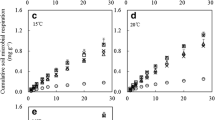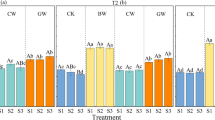Abstract
To understand the effects of soil temperature and moisture on rice straw decomposition during the off-rice season and subsequent CH4 production in rice growth season, we firstly incubated a paddy soil with 13C-labeled straw addition under four temperature (±5, 5, 15, and 25 °C) and two moisture levels (60 and 100 % water-filled pore space (WFPS)) under aerobic conditions for 24 weeks and subsequently incubated those samples anaerobically at 30 °C and under submerged conditions for 4 weeks. Temperature change at ±5 °C was used to simulate the diurnal variation of soil temperature between night (−5 °C, 12 h) and day (5 °C, 12 h) during the corresponding freeze-thaw cycles. Our results showed that both increased soil temperature and moisture significantly promoted straw aerobic decomposition as observed by carbon dioxide (CO2) production, soil organic carbon (SOC) content, and its δ13C value in this incubation experiment. During the anaerobic incubation, straw-amended soil samples remarkably promoted CH4 production and CH4/total decomposed C. Both CH4 and CO2 productions in straw-amended soil samples were lowest at 25 °C and 100 % WFPS and highest at ±5 °C and 100 % WFPS, which could be attributed to a depletion of labile organic C derived from straw during the 24-week aerobic incubation. Total rates of straw C decomposition calculated from decomposed C production, SOC content, and δ13C value in the whole incubation (aerobic + anaerobic) ranged from 29.8 to 48.1, 45.0 to 64.2, and 25.7 to 35.7 %, respectively. These results imply that increasing soil temperature during the off-rice season promotes the rice straw decomposition and leads to a decrease in CH4 production during the subsequent rice growth season under conditions of northeastern Japan.

Similar content being viewed by others
References
Aulakh MS, Doran JW, Walters DT, Mosier AR, Francis DD (1991) Crop residue type and placement effects on denitrification and mineralization. Soil Sci Soc Am J 55:1020–1025
Cassman KG, Pingali PL (1995) Intensification of irrigated rice systems: learning from the past to meet future challenges. Geo J 1995:299–305
Cheng W, Tsututa H, Chen G, Yagi K (2004) N2O and NO production in various Chinese agricultural soils by nitrification. Soil Biol Biochem 36:953–963
Cheng W, Yagi K, Akiyama H, Nishimura S, Sudo S, Fumoto T, Hasegawa T, Hartley AE, Megonigal JP (2007) An empirical model of soil chemical properties that regulate methane production in Japanese rice paddy soils. J Environ Qual 1920–1925
Cheng W, Sakai H, Yagi K, Hasegawa T (2010) Combined effects of elevated [CO2] and high night temperature on carbon assimilation, nitrogen absorption, and the allocations of C and N by rice (Oryza sativa L.). Agric For Meteorol 150:1174–1181
Cheng W, Padre AT, Sato C, Shiono H, Hattori S, Kajihara A, Aoyama M, Tawaraya K, Kumagai K (2016) Changes in the soil C and N contents, C decomposition and N mineralization potentials in a rice paddy after long-term application of inorganic fertilizers and organic matters. Soil Sci Plant Nutr. doi:10.1080/00380768.2016.1155169
Chidthaisong A, Watanabe I (1997) Methane formation and emission from flooded rice soil incorporated with 13C-labeled rice straw. Soil Biol Biochem 29:1173–1181
Conrad R (1999) Contribution of hydrogen to methane production and control of hydrogen concentrations in methanogenic soils and sediments. FEMS Microbiol Ecol 28:193–202
Conrad R, Klose M, Yuan Q, Lu Y, Chidthaisong A (2012) Stable carbon isotope fractionation, carbon flux partitioning and priming effects in anoxic soils during methanogenic degradation of straw and soil organic matter. Soil Biol Biochem 49:193–199
Devêvre OC, Horwáth WR (2000) Decomposition of rice straw and microbial carbon use efficiency under different soil temperatures and moisture. Soil Biol Biochem 32:1773–1785
Fores E, Menendez M, Comin FA (1988) Rice straw decomposition in rice-field soil. Plant Soil 109:145–146
Forster P, Ramaswamy V, Artaxo P, Berntsen T, Betts R, Fahey DW, Haywood J, Lean J, Lowe DC, Myhre G, Nganga J, Prinn R, Raga G, Schulz M, Van Dorland R (2007) Changes in atmospheric constituents and in radiative forcing. Contribution of Working Group I to the Fourth Assessment Report of the Intergovernmental Panel on Climate Change. In: Solomon S, Qin D, Manning M, Chen Z, Marquis M, Averyt KB, Tignor M, Miller HL (eds) Climate change 2007. Cambridge, United Kingdom, pp 129–234
Huang S, Sun Y, Yu X, Zhang W (2015) Interactive effects of temperature and moisture on CO2 and CH4 production in a paddy soil under long-term different fertilization regimes. Biol Fertil Soils. doi:10.1007/s00374-015-1075-3
Jia X, Shao MA, Wei X, Li X (2014) Response of soil CO2 efflux to water addition in temperate semiarid grassland in northern China: the importance of water availability and species composition. Biol Fertil Soils 50:839–850
Kimura M, Murase J, Lu Y (2004) Carbon cycling in rice field ecosystems in the context of input, decomposition and translocation of organic materials and the fates of their end products (CO2 and CH4). Soil Biol Biochem 36:1399–1416
Kondo M, Yasuda M (2003) Seasonal changes in N2 fixation activity and N enrichment in paddy soils as affected by soil management in northern area of Japan. Jarq-Japan Agric Res Q 37:105–111
Lelieveld J, Crutzen PJ, Dentener FJ (1998) Changing concentration, lifetime and climate forcing of atmospheric methane. Tellus Ser B Chem Phys Meteorol 50:128–150
Lim SS, Kwak JH, Lee KS, Chang SX, Yoon KS, Kim HY, Choi WJ (2015) Soil and plant nitrogen pools in paddy and upland ecosystems have contrasting δ15N. Biol Fertil Soils 51:231–239
Linn DM, Doran JW (1984) Aerobic and anaerobic microbial populations in no-till and plowed soils. Soil Sci Soc Am J 48:794–799
Liu W, Wu W, Lu H, Chen Y (2014) Carbon flux from decomposing 13C-labeled transgenic and notransgenic parental rice straw in paddy soil. J Soils Sediments 14:1659–1668
Lugato E, Berti A, Giardini L (2006) Soil organic carbon (SOC) dynamics with and without residue incorporation in relation to different nitrogen fertilisation rates. Geoderma 135:315–321
Matzner E, Borken W (2008) Do freeze-thaw events enhance C and N losses from soils of different ecosystems? A review. Eur J Soil Sci 59:274–284
Menichetti L, Ortigoza ALR, García N, Giagnoni L, Nannipieri P, Renella G (2015) Thermal sensitivity of enzyme activity in tropical soils assessed by the Q10 and equilibrium model. Biol Fertil Soils 51:299–310
Myhre G, Shindell D, Bréon FM, Collins W, Fuglestvedt J, Huang J, Koch D, Lamarque JF, Lee D, Mendoza B, Nakajima T, Robock A, Stephens G, Takemura T, Zhang H (2013) Anthropogenic and natural radiative forcing. In: Stocker TF, Qin D, Plattner GK, Tingnor M, Allen SK, Boschung J, Nauels A, Xia Y, Bex V, Midgley PM (eds) Climate change 2013: the physical science basis. Contribution of Working Group I to the Fifth Assessment Report of the Intergovernmental Panel on Climate Change. Cambridge University Press, United Kingdom, pp 659–740
Naser HM, Nagata O, Tamura S, Hatano R (2007) Methane emissions from five paddy fields with different amounts of rice straw application in central Hokkaido, Japan. Soil Sci Plant Nutr 53:95–101
Rochette P, Flanagan LB, Gregorich EG (1999) Separating soil respiration into plant and soil components using analyses of the natural abundance of carbon-13. Soil Sci Soc Am J 63:1207–1213
Sain P, Broadbent FE (1977) Decomposition of rice straw in soils as affected by some management factors. J Environ Qual 6:96–100
Schimel JP, Gulledge J (1998) Microbial community structure and global trace gases. Glob Chang Biol 4:745–758
Sierra CA, Trumbore SE, Davidson EA, Vicca S, Janssens I (2015) Sensitivity of decomposition rates of soil organic matter with respect to simultaneous changes in temperature and moisture. J Adv Model Earth Syst 7:335–356
Soil Survey Staff (1999) Soil taxonomy: a basic system of soil classification for making and interpreting soil surveys, second ed, Agriculture Handbook Number 436, US Department of Agriculture and Natural Resources Conservation Service. US Gov. Print. Office, Washington, DC
Suseela V, Conant RT, Wallenstein MD, Dukes JS (2012) Effects of soil moisture on the temperature sensitivity of heterotrophic respiration vary seasonally in an old-field climate change experiment. Glob Chang Biol 18:336–348
Tierney GL, Fahey TJ, Groffman PM, Hardy JP, Fitzhugh RD, Driscoll CT (2001) Soil freezing alters fine root dynamics in a northern hardwood forest. Biogeochemistry 56:175–190
von Lützow M, Kögel-Knabner I (2009) Temperature sensitivity of soil organic matter decomposition—what do we know? Biol Fertil Soils 46:1–15
Wallenstein M, Allison SD, Ernakovich J, Steinweg JM, Sinsabaugh RL (2011) Controls on the temperature sensitivity of soil enzymes: a key driver of in-situ enzyme activity rates. In: Shukla G, Varma A (eds) Soil enzymology. Springer, Berlin, pp 245–258
Watanabe A, Takeda T, Kimura M (1999) Evaluation of carbon origins of CH4 emitted from rice paddies. J Geophys Res 104:623–629
Xu X, Duan C, Wu H, Li T, Cheng W (2016) Effect of intensity and duration of freezing on soil microbial biomass, extractable C and N pools, and N2O and CO2 emissions from forest soils in cold temperature region. Sci China Earth Earth Sci 59:156–169
Yan X, Akiyama H, Yagi K, Akimoto H (2009) Global estimations of the inventory and mitigation potential of methane emissions from rice cultivation conducted using the 2006 Intergovernmental Panel on Climate Change Guidelines. Glob Biogeochem Cycles 23:20–23
Yanai Y, Toyota K, Okazaki M (2004) Effects of successive soil freeze-thaw cycles on nitrification potential of soils. Soil Sci Plant Nutr 50:821–829
Yang X, Shang Q, Wu P, Liu J, Shen Q, Guo S, Xiong Z (2010) Methane emissions from double rice agriculture under long-term fertilizing systems in Hunan, China. Agric Ecosyst Environ 137:308–316
Ye R, Doane T, Morris J, Horwath W (2015) The effect of rice straw on the priming of soil organic matter and methane production in peat soils. Soil Biol Biochem 81:98–107
Yuan Q, Pump J, Conrad R (2012) Partitioning of CH4 and CO2 production originating from rice straw, soil and root organic carbon in rice microcosms. PLoS ONE 7, e49073
Yuan Q, Pump J, Conrad R (2014) Straw application in paddy soil enhances methane production also from other carbon sources. Biogeosciences 11:237–246
Zhang G, Yu H, Fan X, Liu G, Ma J, Xu H (2015) Effect of rice straw application on stable carbon isotopes, methanogenic pathway and fraction of CH4 oxidized in a continuously flooded rice field in winter season. Soil Biol Biochem 84:75–82
Zhou W, Hui D, Shen W (2014) Effects of soil moisture on the temperature sensitivity of soil heterotrophic respiration: a laboratory incubation study. PLoS ONE 9, e92531
Zou J, Huang Y, Jiang J, Zheng X, Sass R (2005) A 3-year field measurement of methane and nitrous emissions from rice paddies in China: effects of water regime, crop residue, and fertilizer application. Glob Biogeochem Cycles 19:1–9
Acknowledgments
We thank Dr. M. Kumugai and Mr. H. Shiono for providing the soil, Mr. T. Takahashi for his help during the analysis of δ13C, and laboratory mates for the assistance on experimental management. This study was partly supported by the National Natural Science Foundation of China (21228701).
Author information
Authors and Affiliations
Corresponding authors
Electronic supplementary material
Below is the link to the electronic supplementary material.
ESM 1
(DOCX 247 kb)
Rights and permissions
About this article
Cite this article
Tang, S., Cheng, W., Hu, R. et al. Simulating the effects of soil temperature and moisture in the off-rice season on rice straw decomposition and subsequent CH4 production during the growth season in a paddy soil. Biol Fertil Soils 52, 739–748 (2016). https://doi.org/10.1007/s00374-016-1114-8
Received:
Revised:
Accepted:
Published:
Issue Date:
DOI: https://doi.org/10.1007/s00374-016-1114-8




